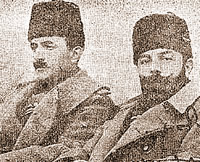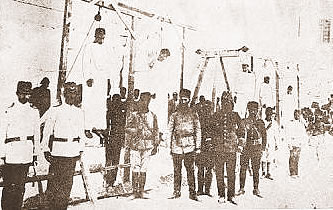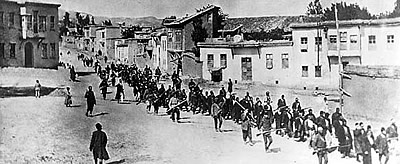The Genocide (part1)
The Turkish Plan
 Leaders of Young Turks, Enver-Pasha (left), and Gemal-Pasha.
Leaders of Young Turks, Enver-Pasha (left), and Gemal-Pasha.
The outbreak of the WWI in 1914 gave the Young Turks the perfect opportunity to solve the Armenian Question. Dr. Nazim, the Young Turks ideologist, traveled throughout the vilayets (provinces) of the Ottoman Empire calling for the boycott of the Armenian businesses. Then Enver-Pasha, the idol of the Turkish revolution issued the order to form special battalions. Later, these units of violent criminals and Kurdish irregulars attacked, looted and burned thousands of Armenian shops in Dyarbekir.
At the same time, Talaat-Pasha, one of the triumvirs and the most influential figure in the Turkish cabinet, ordered to carry out the disarmament of the Armenian villages. Since the Moslem Turkey was involved in war against the Christian countries, the Christian Armenians were considered “unreliable” and sympathizing to their coreligionists. The weapons collected from the Armenians were distributed in neighboring Turkish villages.
Disarmed, arrested and executed
 Photo taken in 1915 in Aleppo, showing Turkish hangmen and their Armenian victims. From the book of James Naser, The First Genocide of the 20th Century: The story of the Armenian Massacres in text and pictures
Photo taken in 1915 in Aleppo, showing Turkish hangmen and their Armenian victims. From the book of James Naser, The First Genocide of the 20th Century: The story of the Armenian Massacres in text and pictures
The Armenian soldiers in the Turkish army were disarmed, put in labor battalions, and then killed. Meanwhile, the legitimated bands of chete (Kurdish irregulars, criminal hirelings) systematically attacked the defenseless Armenian villages raping women and ransacking houses.
In all major cities, the Armenian businesses were looted under the convenient pretext of “war contributions”. In October 1914, mass arrests and killings of Armenians were reported in Erzerum and Zeytun.
In November, as Russia had declared war on Turkey, the jihad (holy war against non-believers) was proclaimed and publicly read in all the vilayets of the Ottoman Empire. Together with the mass execution of the Armenian soldiers in the army, a number of notable Armenian community leaders, including religious were slain in different cities. In the provinces, the Armenian bakers were publicly charged for poisoning the bread of the Turkish Army.
Hypocricy of Turkish leaders
 Talat-Pasha, main architect of the Genocide.
Talat-Pasha, main architect of the Genocide.
In March, 1915 a special decision to exterminate all Armenians throughout the Ottoman Empire was already issued by the Ittihad committee. Meanwhile, a severe censorship was established, and all foreign postal offices in Turkey were closed. Even the neutral US Ambassador was unable to read uncensored dispatches from his own government.
In Constantinople, where a large number of Europeans, including foreign ambassadors were present, the Turkish leaders made hypocritical speeches. Enver-Pasha congratulated the brave Armenian soldiers for their admirable service on the Caucasus front, while Talaat-Pasha met with the Armenian leaders shortly before their mass arrests and told them that they had nothing to fear.
Armenian resistance
 Exodus from Van, photo taken in April 1915
Exodus from Van, photo taken in April 1915
In April, 1915 the regular Turkish troops began the non-stop attacks on the city of Van. The Armenians under the leadership of Aram Manukian organized a heroic defense. They decided to rise up arms after they were informed that about 30 thousand Armenians had been killed in surrounding villages.
The desperate defense of Van lasted 36 days. Armenians lost 55 thousand men. The survivors were rescued by the units of the Armenian volunteers serving in the Russian army on the Caucasus front. Later, a handful of unarmed Armenians desperately defended themselves in Shabin-Karahisar, the native village of General Andranik.
 The French warship Guichen participated along with several cruisers in the rescue of Armenians who had taken shelter on Musa Dagh.
The French warship Guichen participated along with several cruisers in the rescue of Armenians who had taken shelter on Musa Dagh.
Another heroic example was the defense of Musa-Dagh (Moses Mountain) in Cilicia, described by Austrian author Franz Werfel in his novel, 40 days of Musa Dagh. The Armenian population of 6 villages took shelter on Musa Mountain, and repeatedly thwarted assaults by Turkish army for some 40 days. The survivors were rescued by French warships and evacuated to Egypt.










